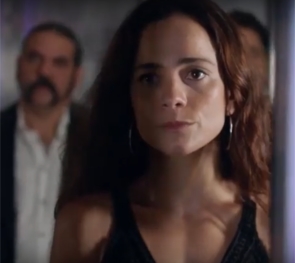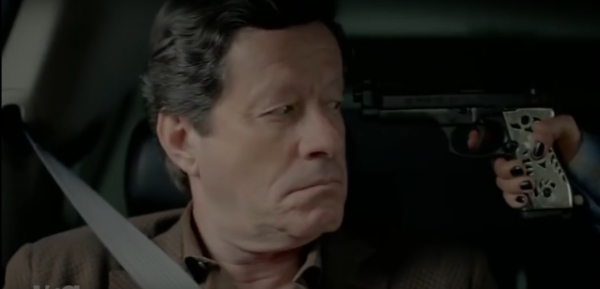In Dallas, Camila has
a club with a suite upstairs where she lurks in the red gloom like a Versace
lizard, usually in a tight red dress and on red 5 inch CFMs. Her movements are
slow and deliberate, like a model moonlighting as a courtesan, prey to a
thousand eyes even when alone sipping a mojito or conducting an
interview with another narco or mule. She crosses and uncrosses her legs
casually, hypnotically... a sexual guillotine between being and nothingness.
She's all female power, a snake from Eden, both coarse and beautiful, a mask
from an Aztec temple. Her expression changes like clouds passing, light,
beautiful, trusting, sympathetic... then closing, dark, ugly and ugly forever.
You don't want to
cross this lady. She's selfish, manipulative and driven. As she says, "Women
don't forgive -- they have to have revenge." She also has a warehouse where her
minions repackage the coke smuggled in from Mexico, Colombia and Bolivia. It's
actually her husband's, but like the secretary who believes she wrote the novel
she's typing, Camila feels she did the work and the business is rightfully
hers. Maybe so. The operation is sectioned into cells by using chain-link
fencing: receiving, cooking, repackaging. There are cells for the mules --
young Mexican women, usually illegals, usually addicts, who live in squalor and
at the mercy of their male narco guards, free to run deliveries but otherwise
slaves. Camila monitors this 'factory' from the comfort of her club with CCTV
cameras. It's a sweet setup, pure capitalism, no taxes, no rules except money
or death. She rides in a black limo SUV, speaks in a monotone husky from
cigarettes and tequila. As mariachi follows flamenco, Camila is the
Hispano-Indian expression of both. She lives in a coke temple, the high
priestess of sex and death.
The Queen of the South
is character driven as the plot is simple, really just a custody fight between
Camila and Epifanio for possession of, a) their coke business, b) their
daughter, and c) Teresa Mendoza, interspersed with parties, gunfights and
torture. The absolute squalor that supports this flash photo of the hi-life is
as depressing as it is funny. Burn me now, burn me later... one ambush after
another... so rip-offs and double-crosses are the routines that separate the
slaughterhouse from the penthouse. All is illusion: the gated villas of old
Culiacán, the gleaming Bentleys loaded with narco dollars, the corporate
party jets, the snake-skin boots, vaquero hats and chrome plated pistols and
AK-47s... all is illusion: the drug factories run by sweating slaves in shabby
underwear, the culverts jammed with the rotting bodies of the unlucky, the
sacks of money and the bricks of blow masquerading as crates of vegetables,
good for you kid, the money, the blow, the illusion. Good for you.
In Reverte's novel, he
collages the corridors (or narco ballads) of the local Mexican folk
groups, the cantina bands, into his exposition of the narco culture. He
suggests that these balladeers, by celebrating the careers of the narcos, give
them cultural validity. The desperado life is easily mythologized,
romanticized, and the corridor allows a moral rehabilitation for the killer
criminal. Like Billy the Kid or the Count of Monte Cristo, who cares how they
made a living if that living was wild and wonderful to relate. The good need
the bad, otherwise they'd never understand the difference. Filha da
puta. We Sinaloans know how to live and die.
James Valdez (Peter
Gadiot). Now here's a guy any aging power Queen would like to have on
retainer. Besides being trustworthy and loyal, he's willing to do just about
anything Camila asks. Who is he? He arrives with no history. Camila has
history, Teresa has history, but James has no CV and a lot of useful skill.
Perhaps you wonder if he's the pliant hard-ass toy boy lover... but there's
never any evidence of that. He has Camila's confidence, he's respectful,
understands the boundaries, no matter the situation. He's the same with Teresa,
even though he's her field boss and mentor. He's athletic and fast, sports a
mild beard, has a faint Latino look, although can pass as American white.
Police radio alert describes him as a "white male, possibly Mexican, 5 foot
ten". A musketeer with a Glock 9, a van, and a trailer in the woods. He's got a
woman, although you keep wondering how long before he and Teresa get it on.
After all, she saves his life once or twice... and he, hers. When Güero
resurrects from the dead, reenters the action as another lieutenant for Camila,
you have two men buzzing around Teresa, and naturally you wonder what's
shakin'. "I've seen how he looks at you," says Güero to Teresa during one
argument, and he repeats this later to James, who just shrugs the notion off.
James might look
middle class, but like the other narcos, he's just a soldier in the dirty war.
But what does he want, wonders Teresa... and he tells her. "I don't have to own
the whole building... just a few bricks." The risk seems incredible for just a
few -- after all, Texas has the death penalty, and he's willing and able to
commit murder on Camila's behalf. He shoots her Dallas rival, 'The Birdman',
himself a ruthless narco killer, so you don't really see his death as murder,
just justice as a sporting proposition. Telescopic rifle, take 'em all out,
him, his guards, make a mess of his post-modern hi-tech villa, leave the birds
screaming in their cages. So again you wonder, who is this James? Ex-military?
He's a mystery waiting to be unlocked... and you're wanting Teresa to unlock
it.
Again, a great example
of film character minimalism, where the credibility is left almost entirely to
the actor. The same can be said about Don Epifanio's capo, Cesar 'Batman'
Guemes (Gerardo Taracema). A great face can carry a film actor a long
way and he has a great face. He's also a two gun pistolero in black
leather with big dreams and a mean streak. At one point he kidnaps Teresa and
is heading for the border intent on bringing her back to Epifanio. When a cop
pulls him over, he subdues Teresa with a stun gun, but as the cop is on
retainer for Camila, all Batman gets for his efforts is a pistol whipping and a
fast, humiliating deportation. As James says to Camila, "There's only one
highway to Mexico."
The series is more
gringo when it comes to music. The mariachi corridor becomes cantina
background noise while gangster rap choreographs the turf rumbles and gun
battles. Georgio Moroder, the Italian composer, is credited with the score, and
the updating to a more international disco pop tribalism certainly works...
mostly. The main theme -- which is a collaboration between Moroder and Raney
Shockne -- does sound a bit cheesy when isolated from the theme credits.
But then, is there
anything more cheesy than basic tequila mariachi? The lurching polka of the
sub-tropics? No matter. It's the poetry of it all that Reverte
extols:
'...and other
gangster (music) groups from Sinaloa and up that way, the ones that turned the
police gazette into music, songs about mules and murders and lead and shipments
of the good stuff, and Cessnas and new pickups, and Federales and cops,
traffickers and funerals. As corridos had been to the Revolution in those
bygone days, so the narcocorridos were the new epics, the modern legends of a
Mexico that was there and had no intention of going anywhere or changing --
among other reasons because a not inconsiderable part of the national economy
depended on the drugs. It was a marginal, hard world, of weapons, corruption
and drugs, in which the only law not broken was the law of supply and demand.'
(Reverte, The Queen of the South)
This aspect is
jettisoned in the TV series, although you could argue that some of the narco
dialogue compensates with its comic book poetics and folksy mysticism. There's
an urge to speak in maxims although these lines never quite make it. Is this
good or bad? The dialogue has that utilitarian feel, where the mouth starts the
conversation and the face finishes it. Yet you can't say it doesn't work, as
there are as many or more conversations than gunfights and expletives. A good
one, for example, is when Epifanio and Batman sit in a Culiacán bistro
and discuss Camila, and a bald citizen comes up and congratulates Epifanio on
his run for Governor, and that he'll be voting for him. The naturalism is
always convincing you of the story's validity, even when the violence sometimes
leaves you numb and insulted. Dogs bark, black crows appear, and everything
becomes supernatural.
Epifanio goes to the
funeral of a dead narco. He's greeted by the victim's brother who fires a few
rounds into the air. "Business will always trump family," says the brother, now
the new boss. You smile, you might even laugh -- sure, sentimentality is for
priests and singers -- although the line isn't quite as quotable as it aspires
to be. The same with Batman's line (from the novel): "Dirty money spends as
green as clean." It's clan culture stuff, authentic and human, but won't make
you reach for your notebook.
How will it
end?
In the novel, after a
final and futile meeting with Don Epifanio Vargas in the chapel, Teresa returns
to her villa to find her bodyguard Pote alone, the legitimate guards having
left in anticipation of her assassination. So she finds herself in The
Situation. How to deal with it? The lethal swarm of narcomafia that must surely
be coming? It will be interesting to see how the writers of the series choose
to wrap it all up. Season 3. You can speculate, of course. Camila instead of
Epifanio, James instead of Guero, love instead of hate... a birth in the ruins,
a baby narco Jesus to keep 'er all going, some other way, some other corridor,
song, cell-phone jingle.
The famous 1950 Gloria
Swanson-William Holden film Sunset Boulevard starts with a dead man floating
face down in a Hollywood pool narrating his own story. The Queen of the South
series starts like this, with La Mexicana lying on the floor of her villa, a
bullet between her eyes. She tells her own story too as the improbable voice
from the dead... yet, is this really how it will all end? Never know... it
might be a false flag. Saints never die -- they just live on in the songs of
the people.
© Lawrence
Russell August 2018
*Check out LR's
OUTLAW
ACADEMIC »»
or LR's novel
RADIO
BRAZIL »»
|
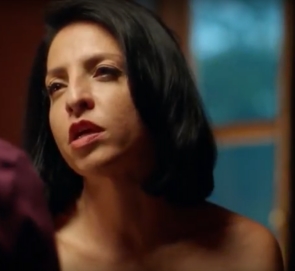
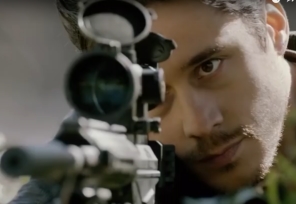
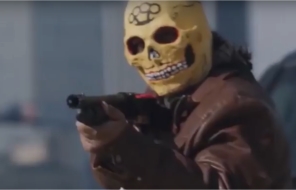

Veronica Falcón talks
about playing Camila »»» |
